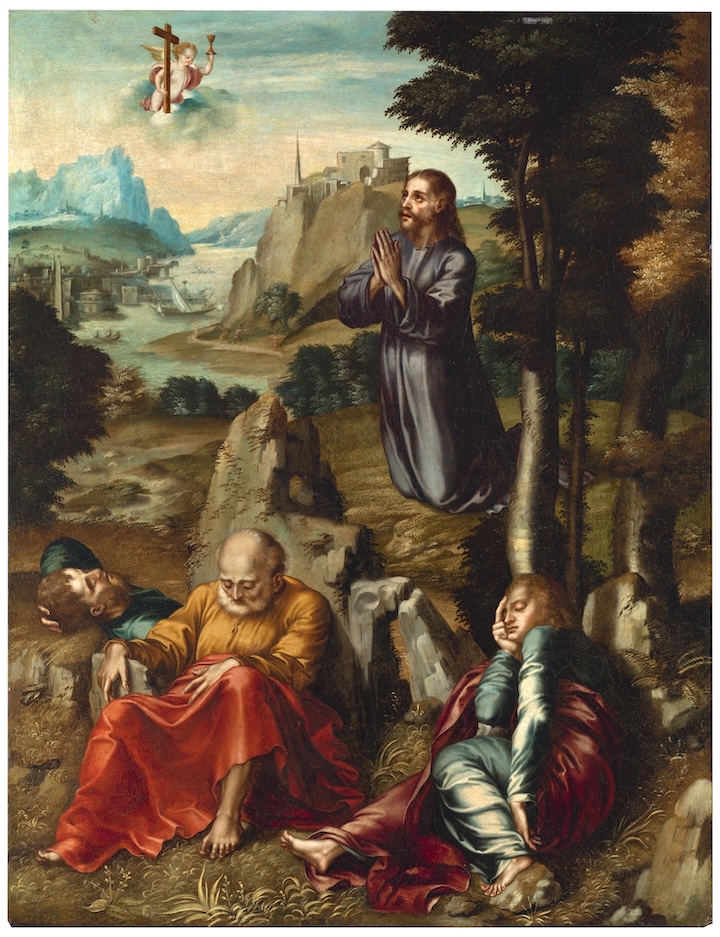As Lent begins again, and with it, the desire to follow Christ on the way to Calvary, I am fascinated, as all Western civilization has been for two millennia, by the Cross at the end of that uphill climb. It is the meeting point of all the things we dread. And perhaps the greatest mystery of all time is that God hung Himself on it.
Over the years I’ve contemplated in turns his physical torment, the loneliness of his desolation, the way he watched his mother watch him die. This Lent a whole new avenue of prayer has been opened for me in St. John Henry Newman’s meditations on the mental suffering of Christ. In a Victorian torrent of words Newman has made me conscious for the first time of something I find utterly shocking: The reality of God’s taking on of sin, the mortal enemy of His very nature.
Since my childhood, I have ritually asked for mercy from the “lamb of God who takes away the sins of the world.” When I have done so, I think I usually have imagined a neat bundle of sins like dried sticks tied to the back of a lamb wandering bleating into the desert. The lamb is snow white, pure and clean as only a lamb can be. The bundle on her back may bow her spine with its weight but it doesn’t stain her, it rests cleanly on her. It’s a pretty picture, but somewhat childish.
Newman’s 1852 sermon, Mental Sufferings of Our Lord in His Passion, presents a terrible prospect to those who love Jesus: that His bodily suffering was as nothing compared to the intolerable pain in His soul. And that this soul-agony results not from the heaviness of sin but from the fact of its being an invasion, voluntarily accepted. Far from simply carrying sin away, He opens his mortal nature to the attack of the Evil One and lets the enemy’s foul deeds infiltrate and permeate Him.
Newman’s incomparable prose captures this facet of Christ’s passion:
There, then, in that most awful hour, knelt the Saviour of the world. . .baring His breast, sinless as He was, to the assault of His foe – of a foe whose breath was a pestilence, and whose embrace was an agony. There He knelt, motionless and still, while the vile and horrible fiend clad His spirit in a robe steeped in all that is hateful and heinous in human crime, which clung close round His heart, and filled His conscience, and found its way into every sense and pore of His mind, and spread over Him a moral leprosy, till He almost felt Himself to be that which He never could be, and which His foe would fain have made Him.
Newman goes on to describe the “Eternal Purity” feeling like a “foul and loathsome sinner” stung by every drop of that “mass of corruption which poured over His head,” of the experience of Jesus looking at His hands and seeing them drenched in the blood of millions of history’s innocents, seeing through eyes profaned by “evil visions and idolatrous fascinations,” His lips “defiled by oaths and blasphemies.”

Every vile sin committed before that day and since has homed in on Him, is on Him and in Him, their reek driving away the “ineffable peace which has inhabited His soul since the moment of His conception.”
No wonder that during the Agony in the Garden, before the first Roman lash had struck Him, the blood broke through His burning veins and out the pores of His skin, beading His whole body and soaking His mantle.
Though it is hard to think of, or to bear for very long, we must look at this image of the immensity of God’s mercy! You and I, we sin, but we barely notice it. We are comfortable with our sinfulness; it has been in us and on us since we were formed. But the Pure One writhed under an alien agony, as though He were the criminal.
Yet Jesus goes further: as Newman observes, His suffering even “takes the form of guilt and compunction. He is doing penance, He is making confession, He is exercising contrition. . .for He is the One Victim for us all, the sole Satisfaction, the real Penitent, all but the real sinner.”
Newman reminds us that Jesus does not allow Himself to die until He has drained the cup – until full atonement has been made – for my sins, and yours, and those of every child of Eve whose deeds have covered our race with shame.
It takes real Lenten courage to contemplate that furthest sadness – God’s death. My own courage often fails me at far less painful sights. But Christ died, St. John Henry Newman tells us, “not of bodily exhaustion, or of bodily pain.” No, having sipped the last drop, He willed His tormented heart to break, and only then did He commend His spirit to His Father.
A severe truth to keep before us these forty days.















